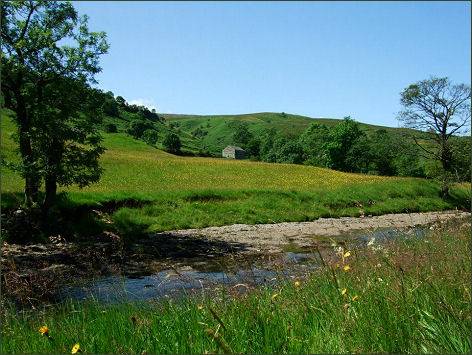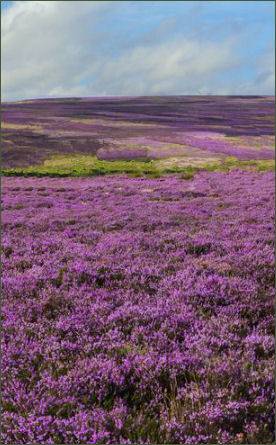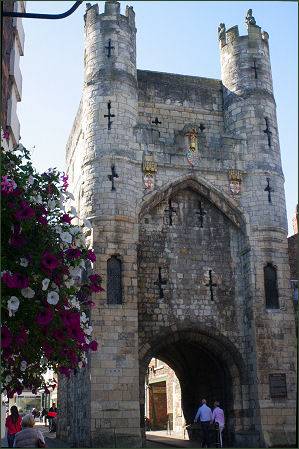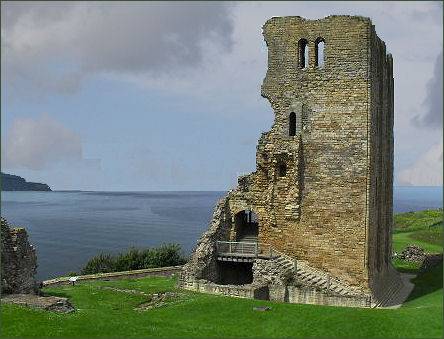North Yorkshire
 The county of North Yorkshire covers an area of 8,654 square kilometres (3,341 sq miles), making it the largest county in England. It was created by the Local Government Act 1972. The county is known for its abbeys, cathedrals, and stately homes as well as its large unspoilt open areas.
The county of North Yorkshire covers an area of 8,654 square kilometres (3,341 sq miles), making it the largest county in England. It was created by the Local Government Act 1972. The county is known for its abbeys, cathedrals, and stately homes as well as its large unspoilt open areas.
The majority of the beautiful Yorkshire Dales and the stunning North York Moors National Parks lie within North Yorkshire's boundaries, and in total around 40% of the county is covered by National Parks.
The Yorkshire Dales National Park encompasses an area of 1,770 square kilometres (680 square miles). which boasts spectacular limestone scenry. The area was designated a National Park in 1954.
The National Park does not include all of the Yorkshire Dales. Parts of the dales to the south and east of the national park form the Nidderdale Area of Outstanding Natural Beauty. Some of the highlights of the Yorkshire Dales include spectacular Aysgarth Falls, which consists of a triple flight of waterfalls in a wooded gorge of the River Ure near the village of Aysgarth. Although not particularly high the waterfalls are one of Wensleydale's most famous beauty spots and stunning Malham Cove, one of the natural wonders of Yorkshire is a natural limestone formation which stands around a kilometre to the north of the village of Malham. A large, curved ampitheatre shaped limestone cliff formation rises to 80 metres (260 feet) and looms over the head of a valley. On the west side of the cliff face are irregular stone steps which form part of the route of the Pennine Way and lead to an uneven limestone pavement at the top.
 In addition there are many attractive villages and towns within the National Park borders, including the market town of Grassington, one of the most popular tourist destinations in the Yorkshire Dales, the picturesque market town of Hawes, set amidst the stunning scenery of Wensleydale is one of the tourist magnets of the Yorkshire Dales. The picturesque village of Hubberholme, in Upper Wharfedale, the picture postcard village of Linton and the highly attractive riverside village of Burnsall in Upper Wharfedale.
In addition there are many attractive villages and towns within the National Park borders, including the market town of Grassington, one of the most popular tourist destinations in the Yorkshire Dales, the picturesque market town of Hawes, set amidst the stunning scenery of Wensleydale is one of the tourist magnets of the Yorkshire Dales. The picturesque village of Hubberholme, in Upper Wharfedale, the picture postcard village of Linton and the highly attractive riverside village of Burnsall in Upper Wharfedale.
The beautiful and tranquil North York Moors National Park contains one of the largest expanses of heather moorland in Britain. The National Park covers an area of 1,436 square kilometres (554 sqare miles). The North York Moors obtained National Park status in 1952. The North York Moors lie to the north and east of the historic City of York and stretch over a broad area from the Vale of York and the Vale of Mowbray across to the Yorkshire Coast.
Popular places to visit in the North York Moors National Park include the characterful village of Hutton-le-Hole, with its picturesque and much photographed village green where sheep still graze. The village is home to the fascinating Ryedale Folk Museum, Yorkshire's leading open air museum, which is set in 5 acres and boasts over 20 historic buildings depicting the lives of ordinary folk from earliest times to the present day. Ryedale itself is a diverse and beautiful area of spectacular scenery, bustling market towns, dale and hill farms, and picturesque villages. Coxwold, one of Yorkshire's most picturesque villages, is located on the southern edge of the North York Moors National Park.
The charming market town of Helmsley is situated 13 miles (21 km) to the west of Pickering at the point where Rye Dale leaves the moorland and joins the Vale of Pickering. Helmsley is an ancient settlement of much character which pre-dates the Norman conquest of 1066, it was referred to in the middle ages as Elmeslac, which means means 'Helm's forest clearing'. The Viking presence in the area is clearly marked in the Old Norse, "gate" ending of the names of many of the town's streets.
The largest settlements in the county are the historic city of York, Middlesbrough, Harrogate, and the popular seaside resort of Scarborough.
 The cathedral city of York, which is steeped in history, has so much to offer the visitor. The medieval walled city has its origins in 71 AD, when it was founded by the Romans, who referred to it as Eboracum, the invading Vikings later renamed it as Jorvik. York has a medieval city wall which stretches for 2.5 miles, 18 medieval churches and several museums. Attractions include the magnificent York Minster, the largest Gothic church in Northern Europe, the National Railway Museum, and the Jorvik Viking Centre.
The cathedral city of York, which is steeped in history, has so much to offer the visitor. The medieval walled city has its origins in 71 AD, when it was founded by the Romans, who referred to it as Eboracum, the invading Vikings later renamed it as Jorvik. York has a medieval city wall which stretches for 2.5 miles, 18 medieval churches and several museums. Attractions include the magnificent York Minster, the largest Gothic church in Northern Europe, the National Railway Museum, and the Jorvik Viking Centre.
York Minster is a masterpiece in stone and stained glass with its foundations rooted in the early history of the nation. The Minster is built on the remains of the Basilica, the ceremonial centre of the Roman fortress at York, the central tower of the minster were built over one corner of the principia. The foundations of the Basilica are visible today in York Minster's Undercroft, Treasury and Crypt. Medieval St. William's College is situated in College Street, adjacent to the Minster. The black and white timber framed frontage of the building is decorated with several interesting features, including oak carvings, coats of arms, and a sundial.
The stylish Yorkshire spa town of Harrogate, England's floral town, became known as 'The English Spa' in the Georgian period. The name Harrogate is first recorded in the fourteenth century as Harwegate. It derives from Old Norse horgr meaning 'a heap of stones. The Montpelier district has a number of tourist attractions, famous for its cafés and restaurants, it also boasts a number of antique shops and is surrounded by beautiful gardens and flower beds. The town is renowned for its well developed café culture, the famous Betty's Tearooms (right) were first opened in 1919 by Frederick Belmont, who sold Swiss confectionery to visitors. The tearooms are owned by Bettys and Taylors of Harrogate, the same company that makes Yorkshire Tea.
 Scarborough is reputed to have been founded around 966 as Skaršaborg by Thorgils Skarthi, a Viking raider, the town later became known as probably the world's first seaside resort in the 1600s, when the health-giving properties of the Spa waters were discovered. Today it is the largest seaside resort on the Yorkshire coast with much to offer the visitor. The popular seaside resort is dominated by the high craggy headland that juts into to the North Sea and separates the Scarborough into two bays, North Bay and South Bay.
Scarborough is reputed to have been founded around 966 as Skaršaborg by Thorgils Skarthi, a Viking raider, the town later became known as probably the world's first seaside resort in the 1600s, when the health-giving properties of the Spa waters were discovered. Today it is the largest seaside resort on the Yorkshire coast with much to offer the visitor. The popular seaside resort is dominated by the high craggy headland that juts into to the North Sea and separates the Scarborough into two bays, North Bay and South Bay.
High on the headland stands the dramatic eleventh century ruins of Scarborough Castle, built in the early twelfth century by the Norman baron William le Gros, Count of Aumale and Holderness during the reign of King Stephen. the castle was constructed on land granted to le Gros in reward for his victory at the Battle of the Standard, when English forces repelled a Scottish invading army on 22 August 1138 on Cowton Moor near Northallerton.The castle has sheer drops to the sea and dominates the town and harbour some 300 feet below.
Historic buildings in North Yorkshire include medieval Middleham Castle which stands in Wensleydale and was the childhood home of King Richard III. Richmond Castle, which occupies a commanding defensive position above the River Swale at Richmond. Originally referred to as Riche Mount, meaning 'the strong hill', the castle was founded in 1071 following the Norman Conquest. A stronghold of medieval kings, Knaresborough Castle was built in around 1100 in a stunning location on a cliff top overlooking the River Nidd. The first reference to the castle occurred in 1129 when it was recorded that 11 pounds was spent on the castle by its custodian Eustice Fitz-John. In the 1170's Hugh de Moreville, one of the knights responsible for the murder of Thomas Beckett, sought refuge there, along with his followers, following the assassination of Archbishop Beckett in Canterbury Cathedral. The ruins of Spofforth Castle, a fortified manor house belonging to the powerful and aristocratic Percy family, one of the most important and influential families in northern England, stands in the village of Spofforth, in North Yorkshire.
Castle Howard near York, one of the premier stately homes of England, is situated in the Howardian Hills, an Area of Outstanding Natural Beauty. The baroque eighteenth century masterpiece was designed by Sir John Vanbrugh for Charles Howard, 3rd Earl of Carlisle. Markenfield Hall was built in the early fourteenth century and still retains its moat, it is one of the finest surviving country houses from that era in England. The hall is siituated 3 miles (5 km) to the south of Ripon.
The atmospheric ruins of Jervaulx Abbey, one of the great Cistercian abbeys of Yorkshire, stand at East Witton near Ripon. It is reputedly the second largest privately owned Abbey in Britain. The name Jervaulx is first recorded in 1145, where it appears as Jorvalle. It means means 'Ure valley' in French, and may be a translation of the English Uredale. Bolton Abbey lies in Wharfedale, to the east of Skipton. The estate acquires its name from Bolton Priory, the twelfth century ruins of an Augustinian monastery. The estate is situated within a highly attractive landscape, adjacent to the village of Bolton Abbey. The Bolton Abbey estate has been a popular tourist destination since the Victorian era. William Wordsworth's poem 'The White Doe of Rylstone' was inspired by a visit to the abbey and it has also been painted by landscape artist Turner. Atmospheric Rievaulx Abbey is situated in an isolated valley near the pretty market town of Helmsley on the edge of the North York Moors National Park.
